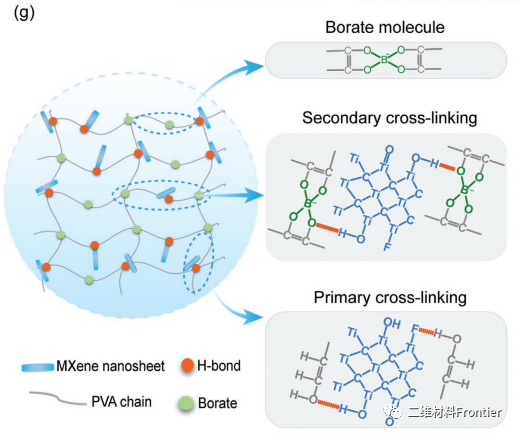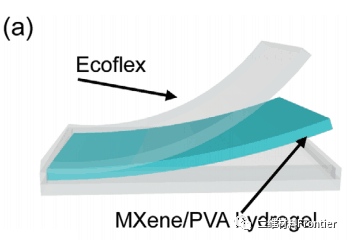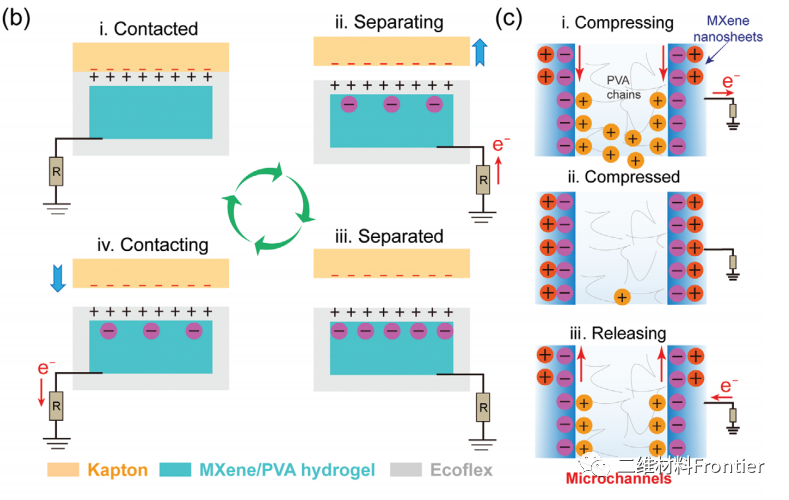
hotline:
17715390137
Tel/Wechat:
18101240246 (Technology)
0512-68565571
Email:mxenes@163.com (Sales Engineer)bkxc.bonnie@gmail.com
Scan the code to follow or search the official account on WeChat:
2D Materials Fronrier After paying attention,
click on the lower right corner to contact us,
Enter enterprise WeChat.
Professional Services Online

I. Overview of the article.
Triboelectric nano-generator (TENGs) is a new technology in energy collection, medical treatment and information technology. Its flexible, portable and self-powered electronic devices based on terminals are ideal, but the complex preparation process and high cost of traditional flexible electrodes hinder its practical application. In this paper, the author introduces a kind of MXene/ polyvinyl alcohol (PVA) hydrogel TENG (MH-TENG), which has the advantages of simple manufacture, high output performance and wide application. The doping of MXene nanosheets promoted the cross-linking of PVA hydrogels and improved the extensibility of the composite hydrogels.MXene nanowafers also form microchannels on the surface, which not only improve the conductivity of hydrogels by improving ion transport, but also generate additional triboelectric output and additional triboelectric output through flow vibrating potential mechanism.
II. guided reading of picture and text.

Figure 1.
Microstructure diagram of MXene/PVA hydrogel.
A) a) schematic diagram of the crystal structure of MXene; b) a low magnification image of the MXene nanosheet obtained by transmission electron microscopy; c) from figure b) the enlarged edge region of the MXene nanosheet; d) a SAED mode MXene nanosheet.

Figure 2.
Self-healing process diagram of MXene/PVA hydrogel.
When the two parts split in the natural environment are connected together, the hydrogel heals quickly and seamlessly. The excellent self-healing and stretchability of MXene/PVA hydrogels come from the rich surface functional groups in MXene nanoparticles, which provide additional hydrogen bonding sites, thus promoting the cross-linking of PVA hydrogels.

Figure 3.
The schematic diagram of MXene/PVA hydrogel of primary and secondary cross-linking networks is shown.
Although MXene nanowires can form strong hydrogen bonds with PVA hydrogels, the structure of MXene nanowires will remain unchanged, so the surface of MXene nanowires can be regarded as a microchannel full of PVA molecular chains and a large amount of water. When water rubbed MXene nanowires, the surface of MXene nanowires will carry negative charge, while the water near the MXene surface will produce positive charge, forming double electric layer and microchannel, in equilibrium and no external vibration.

Figure 4.
The schematic diagram of the structure of MH-TENG.

Figure 5.
Schematic diagram of superimposed structure of Ti3C2Tx aerogel and thin film.
B) the working principle of single-electrode mode MH-TENG for energy collection; c) the three-electric mechanism based on MXene/PVA hydrogel microchannel. When pressure is applied to the MH-TENG, the microchannel is compressed and water flows out of the microchannel. The flowing water will discharge the positive equilibrium ions from the bilayer microchannels, but remain negatively charged on the surface of the MXene. Therefore, the free electrons in the external circuit will be repelled to the ground and the corresponding positive charge will be induced on the MXene nanowires. Therefore, MXene nanoparticles can not only be used as cross-linking agents to improve the stretchability of PVA hydrogels, but also help to form microchannels and promote the transport of positive ions in MXene/PVA hydrogels after triboelectrification.

Figure 6.
MH-TENG is used to perceive different handwritten details.
The image above reveals the good characteristics of the MH-TENG autonomous tactile sensor for highly sensitive handwriting recognition systems. The pen used in the picture is a polyvinyl chloride plastic. MH-TENG can generate special voltage signals with different peak shapes and numbers according to the pressure of the pen tip. MH-TENG can generate special voltage signals with different peak shapes and numbers according to the pressure of the pen tip.
III. Summary of the full text.
To sum up, a flexible and scalable triboelectric nano-generator was prepared using MXene/PVA hydrogel as electrode. MXene nanoparticles not only promote the cross-linking of PVA hydrogels, but also form microchannels in the hydrogels, enhance ion transport, and induce additional output through the SVP mechanism of microchannel trisomy electricity. In addition, MH-TENG s independent triboelectric materials can be combined with a variety of materials, showing great potential in low-frequency mechanical energy collection. It is worth noting that MH-TENG is biodegradable and environmentally friendly, which is suitable for the environmental protection concept currently advocated.
This information is from the Internet for academic exchange only. if there is any infringement, please contact us to delete it immediately.

| Reminder: Beijing Beike New Material Technology Co., Ltd. supplies products only for scientific research, not for humans |
| All rights reserved © 2019 beijing beike new material Technology Co., Ltd 京ICP备16054715-2号 |